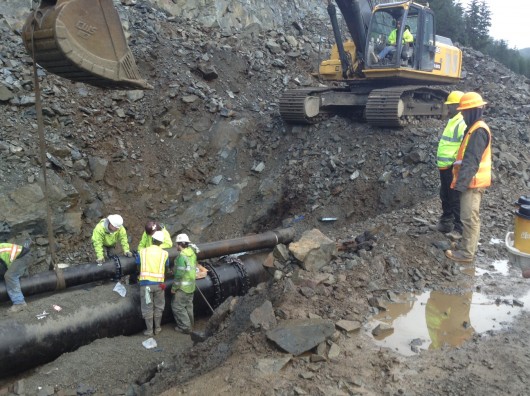
After a contractor accidentally ruptured Sitka’s primary water main, workers rushed to repair it. (Photo courtesy of Jay Sweeney)
Last week, Sitka’s primary water main was ruptured when a contractor on Sawmill Creek Road accidentally blasted through it. That cut off Sitka’s connection to the Blue Lake reservoir, the town’s main water supply. At the time of the break, the city had about 12 hours of water in storage tanks, and the main was repaired before those tanks ran out. But it raised the question: What if it hadn’t been fixed in time?
Listen to iFriendly audio here.
At about 8pm on Wednesday, October 9, many Sitkans received a red alert phone call from the Sitka Police Department. The call informed them that a contractor on Sawmill Creek had ruptured the main water line to town, and said that Sitka had 12 hours of water left in its tanks. It asked everyone to conserve water until further notice.
Many people weren’t quite sure how to respond. Should they avoid doing laundry? Put off their evening shower? Or was the situation more dire? The alert prompted a run on bottled water at local grocery stores. Many residents filled water containers or even bathtubs at home.
But Sitka was never in danger of running out of water, said Michael Harmon, the city’s Public Works Director. If city officials had determined that workers couldn’t repair the main within the 12-hour window, the city would have turned to its backup water source, Indian River. Harmon said it would take about four hours to get the pumps at Indian River up and running.
Indian River used to be Sitka’s primary water source, before the Blue Lake reservoir. But it’s no longer considered safe for drinking, because of tightened environmental standards and the river’s increased salmon population. So while it would be fine for, say, flushing toilets, residents would have to boil water for cooking. Restaurants and fish processors couldn’t use it. Neither could school cafeterias.
And, said Harmon, here’s the most important point: as soon as Sitka crosses that threshold, and starts pumping water from Indian River into the city’s water system, then, even after the water main is repaired, it would take two weeks to flush out the system before the city’s water is safe to drink.
“Any time you’re putting water in that isn’t properly treated, you have to flush the system out and do all kinds of testing,” Harmon said. “When you’re talking about flushing out the whole system, it’s a lot of water and a lot of time.”
The city asked residents to conserve water, to stretch what was left in the storage tanks for as long as possible, to give the crew more time to work and put off the moment when the town would have to turn to Indian River.
“The more you conserve, the less of an issue we’re going to have,” Harmon said. “So, yes, don’t take a shower, don’t wash your dishes, don’t use the water.”
But that’s not quite what happened. Behind the scenes on October 9, city officials wrestled with what to tell residents.
“On the one hand, you don’t want to underplay it, you don’t want to say, ah, it’s nothing,” said interim City Administrator Jay Sweeney. “But you don’t want to spook the herd either, and cause everyone to go into massive water hoarding that could move it across the line.”
“I heard stories of folks filling up their bathtubs and different containers with water,” Harmon said. “That was just the opposite effect than we wanted to have. The notice was for conservation, and if your bathtub looks anything like mine, you know, the Indian river water is gonna be a much better source for you down the line.”
Harmon says the whole experience demonstrates the need for alternative water source for Sitka. One option is drilling a well in Starrigavin Valley. In the shorter run, the city would like to add more water storage.
But drilling wells and installing more storage both come with hefty price tags: About $7 or $8 million to install a line from Starrigavin Valley and about $3.5 million to add another storage tank.
Sweeney says the city will be conducting a review to see what officials could have done better. But Sitkans could also do better next time, said Fire Chief Dave Miller, who heads up the city’s emergency response team.
“Listen to what that phone call has to say,” Miller said. ” And if we ask you to conserve water, don’t use it…If we conserve water we maybe have more hours. If you fill up your bathtub, we have less hours to do anything.”
Sweeney agreed. “To some degree you have to trust that you have professionals in case monitoring the situation,” he said. “Don’t assume it’s a worst case scenario or panic.”






























